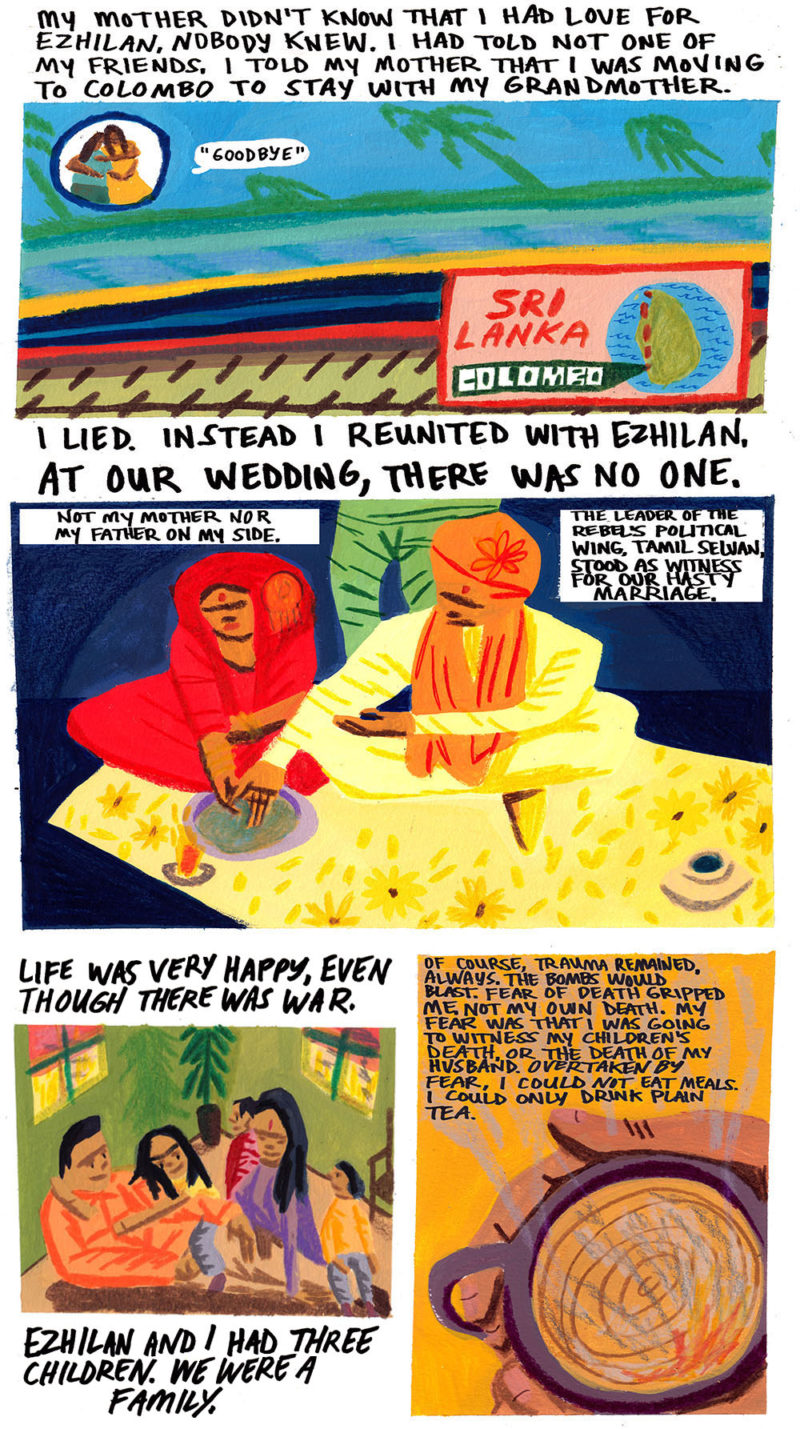, ‘Narratively,’ August 12, 2016
As Sri Lanka’s bitter civil war ground to a bloody end, many rebel leaders disappeared, never to be seen again. Seven years later, one wife wants answers.
Ananthi Sasitharan, 44, is the wife of a senior rebel leader who disappeared in the war’s final days. She is one of just a few people who have spoken out to demand answers on behalf of the missing.


Ananthi and Ezhilan were married in 1998. Around this time, the LTTE fought with theIndian Peace Keeping Force, which had been deployed to keep peace between Sri Lankan Tamil nationalists and the Sri Lankan government. Whereas other Tamil nationalist groups submitted, the LTTE refused to lay down their arms. As a result, the LTTE grew even more powerful.
Norway brokered a cease-fire agreement between the LTTE and the Sri Lankan government in 2002. The fragile truce broke down the following year. For the next two years, both the government and rebels repeatedly violated the cease-fire agreement. Around this time, the Sri Lankan government reframed what had historically been known as an ethnic conflict as a “war against terrorism.” Under control of a newly elected President Mahinda Rajapaska, in 2005, the Sri Lankan government changed its strategic objective from negotiating with the LTTE to annihilating it.
May 18, 2009, the Sri Lankan government accomplished their goal and declared itself victorious. After decades of conflict, mutual hatred, and with the slaughtering of tens of thousands of Tamils, the government had defeated the LTTE militarily and brought the entire country under its control.
 After this event, the army forced Sasitharan and her family to board a crowded bus traveling toward an unknown destination. Sasitharan’s eight-year-old daughter cried in pain. One month earlier, her daughter had an operation for appendicitis. The stitches still had not been removed and the wound became infected.
After this event, the army forced Sasitharan and her family to board a crowded bus traveling toward an unknown destination. Sasitharan’s eight-year-old daughter cried in pain. One month earlier, her daughter had an operation for appendicitis. The stitches still had not been removed and the wound became infected.
When the bus stopped and its occupants were allowed off, Sasitharan showed her daughter’s swollen stomach to a soldier, who pointed her in the direction of a hospital. Inside, a doctor told Sasitharan her daughter’s condition was critical, but she would have to go to a different hospital under the army’s control.
By then, many of the Tamil had taken an anti-LTTE stance. In the UN Report, the LTTE were accused of crimes against their own people for decades leading up to the war’s end, including forcibly recruiting young men, women and children into the rebel army. During the final phase, the report accuses Tiger rebels of using force to stop thousands of civilians trying to escape the war zone, including shooting and sometimes killing their own people rather than allowing them to flee. Also in the UN report, the LTTE is accused of prioritizing the transport of injured soldiers over civilians and claiming food and medicine provided by the government and relief agencies for themselves. Ananthi Sasitharan’s own husband was accused of being in charge of the forcible conscription of large numbers of Tamil children during the final stages of the war as well as blocking the community’s water supply, depriving his own people of potable water.
 Sasitharan and her children escaped unharmed and reunited in India. During their three-month stay there, the children went to a good school. There were opportunities to go abroad. Although they could have started a new life there, Sasitharan says her children demanded they return to Sri Lanka and find their father.
Sasitharan and her children escaped unharmed and reunited in India. During their three-month stay there, the children went to a good school. There were opportunities to go abroad. Although they could have started a new life there, Sasitharan says her children demanded they return to Sri Lanka and find their father.

It was then that Sasitharan entered politics. In 2013 she ran for the Northern Provincial Council. The day of her election, the opposition released a fake edition of her political party’s newspaper falsely claiming she had defected to the opposing side. But her supporters were not thrown by the ruse, and she won anyway.

.xx